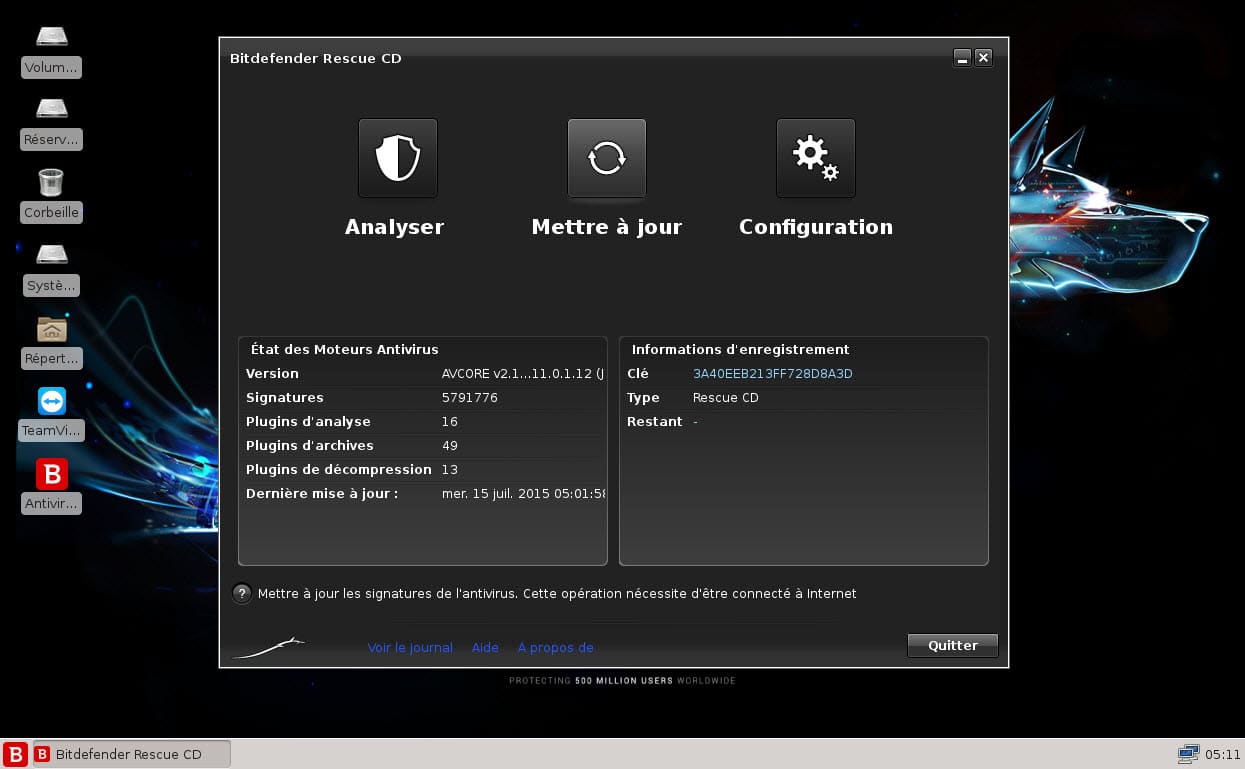

The same CD or USB thumb drive start automatically on other computer systems. Kernel howtogeek/utils/bitdefender/casper/vmlinuzĪppend file= /cdrom/preseed/ed boot=casper initrd=howtogeek/utils/bitdefender/casper/initrd. Bitdefender RescueCD versions 2011 to 2014 randomly require username and password to login to rescuecd.unknowndomain computer console, as described in this blog.
 Append to it the following: label BitDefender Rescue Live. Create the PXE menu entry by editing the "Utils" menu: sudo vim /tftpboot/howtogeek/menus/utils.cfg. Restart the NFS service for the settings to take affect: sudo /etc/init.d/nfs-kernel-server restart. Append to it the pointer to our ISO mount point: /tftpboot/howtogeek/utils/bitdefender *(ro,sync,no_wdelay,insecure_locks,no_root_squash,insecure). Create an NFS share by editing the "exports" file: sudo vim /etc/ exports. Kickass Undelete 1.5.5 BitDefender RescueCD SX WiFi Security Suite 7. If all went well, you should be able to list the contents of the ISO by issuing: ls -lash /tftpboot/howtogeek/utils/bitdefender/ BitDefender RescueCD (USB) is for creating a bootable CD or USB (flash drive) to use on a computer that will not boot up to Windows due to damage caused by virus, trojans, worms or rootkits. Hi, I have already seen one topics asking for the password on Bitdefender rescue disk. Test that the mount point works by issuing: sudo mount -a IODIN burned of Rescue-CD-627.html on adenine -RW DVD also installed it in the PATA DVD drive and booted, it blanket the computer until bitdefender poppped up and then EMBLEM for about 3 min. Append to "fstab" the ISO mount entry: /tftpboot/howtogeek/utils/bitdefender-rescue-cd.iso /tftpboot/howtogeek/utils/bitdefender udf,iso9660 user,loop 0 0 Note: Despite representation, this is one unbroken line. Edit the "fstab" file to have the ISO auto-mounted at boot: sudo vim /etc/fstab. Create the mount point: sudo mkdir -p /tftpboot/howtogeek/utils/bitdefender. Download the latest ISO from bitdefender's site and put it in the "/tftpboot/howtogeek/utils/".
Append to it the following: label BitDefender Rescue Live. Create the PXE menu entry by editing the "Utils" menu: sudo vim /tftpboot/howtogeek/menus/utils.cfg. Restart the NFS service for the settings to take affect: sudo /etc/init.d/nfs-kernel-server restart. Append to it the pointer to our ISO mount point: /tftpboot/howtogeek/utils/bitdefender *(ro,sync,no_wdelay,insecure_locks,no_root_squash,insecure). Create an NFS share by editing the "exports" file: sudo vim /etc/ exports. Kickass Undelete 1.5.5 BitDefender RescueCD SX WiFi Security Suite 7. If all went well, you should be able to list the contents of the ISO by issuing: ls -lash /tftpboot/howtogeek/utils/bitdefender/ BitDefender RescueCD (USB) is for creating a bootable CD or USB (flash drive) to use on a computer that will not boot up to Windows due to damage caused by virus, trojans, worms or rootkits. Hi, I have already seen one topics asking for the password on Bitdefender rescue disk. Test that the mount point works by issuing: sudo mount -a IODIN burned of Rescue-CD-627.html on adenine -RW DVD also installed it in the PATA DVD drive and booted, it blanket the computer until bitdefender poppped up and then EMBLEM for about 3 min. Append to "fstab" the ISO mount entry: /tftpboot/howtogeek/utils/bitdefender-rescue-cd.iso /tftpboot/howtogeek/utils/bitdefender udf,iso9660 user,loop 0 0 Note: Despite representation, this is one unbroken line. Edit the "fstab" file to have the ISO auto-mounted at boot: sudo vim /etc/fstab. Create the mount point: sudo mkdir -p /tftpboot/howtogeek/utils/bitdefender. Download the latest ISO from bitdefender's site and put it in the "/tftpboot/howtogeek/utils/". 
#BITDEFENDER RESCUE CD LOGIN HOW TO#
What you would do is repeat the steps taken in the How To Network Boot (PXE) The Ubuntu LiveCD guide, which were:







 0 kommentar(er)
0 kommentar(er)
